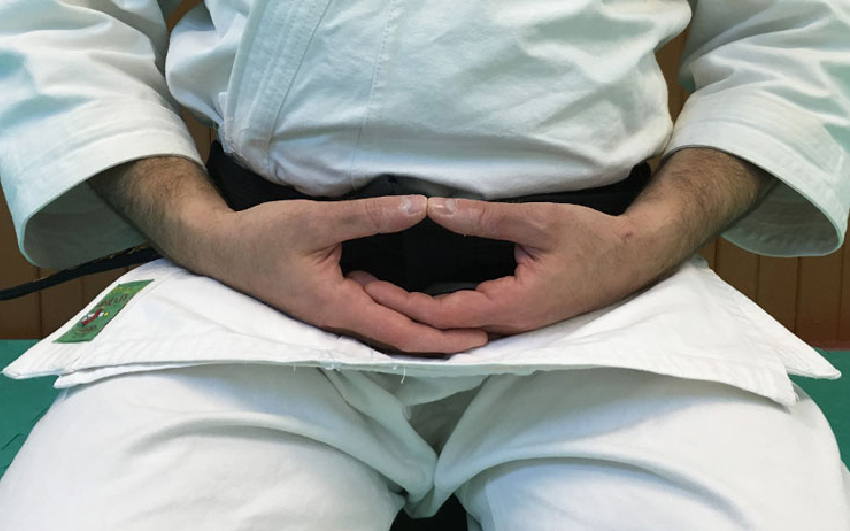What is Meiso and Mokuso?
Karate Meditation is a holistic practice that goes beyond physical training, deeply integrating the development of the mind and spirit.
Central to this aspect of karate are the practices of Meiso and Mokuso, forms of meditation that play a crucial role in a practitioner’s journey. These meditative practices are not just ancillary components; they are fundamental to the essence of karate, offering pathways to inner peace, mental clarity, and heightened self-awareness.
In this article, we will explore the origins, practices, and benefits of Meiso and Mokuso, uncovering how they transform practitioners into well-rounded individuals, skilled not only in martial arts but also in mindfulness and self-reflection. This exploration reveals the depth and richness of karate, a martial art that is as much about cultivating the strength of the spirit as it is about honing the skills of the body.
PS: Discover 10 ways meditation can improve your Karate, it’s worth reading.
What is the Origin of Meiso and Mokuso?
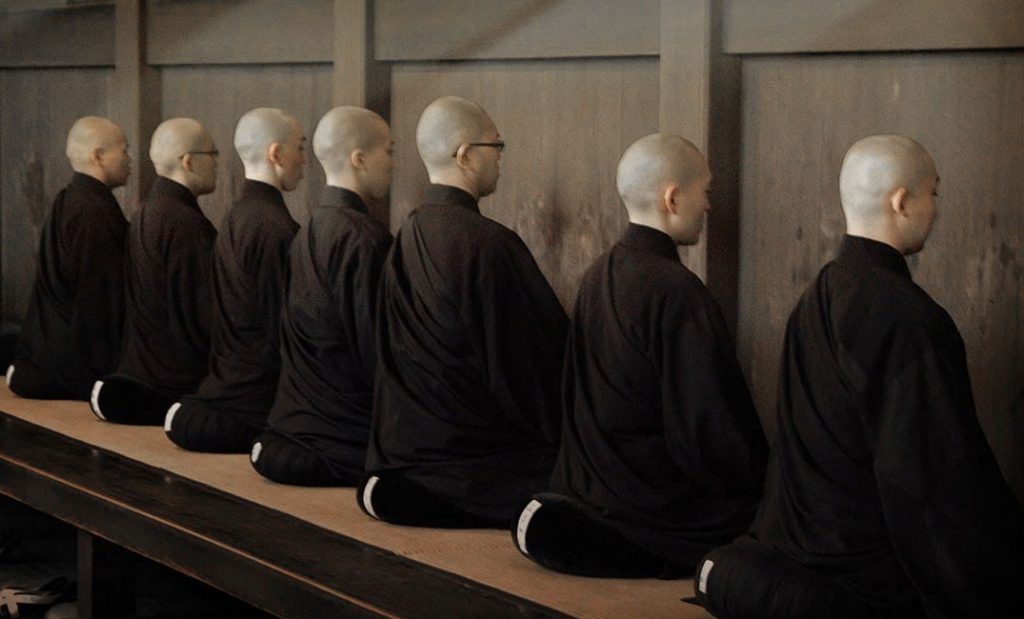
The origins of Meiso and Mokuso in karate are deeply rooted in the historical practices of meditation in martial arts, which can be traced back to the Shaolin monks of China. Established around the 5th century, the Shaolin Temple became a pivotal point for integrating meditation into martial arts.
The monks at Shaolin practiced meditation to enhance focus and discipline and cultivate inner peace and wisdom, elements they deemed essential for true mastery of martial arts. As these meditative practices evolved and spread across Asia, Zen Buddhism in Japan profoundly influenced them.
Zen Buddhism emphasizes mindfulness, deep contemplation, and the pursuit of spiritual enlightenment. This cultural and spiritual fusion led to practices like Meiso and Mokuso in karate.
These practices reflect the Zen Buddhist principles of inner peace, heightened awareness, and the harmonious balance of mind, body, and spirit, aiming to transcend physical abilities to attain deeper wisdom and understanding.
What are Meiso and Mokuso?
While often used interchangeably, Meiso and Mokuso are distinct types of meditation practiced in karate, each with its unique focus and purpose. Both forms are integral to karate training, emphasizing the development of mental discipline and inner harmony. However, as you will see, they differ in their approach and the state of mind they aim to cultivate.
What is Meiso?
Meiso in karate is a meditation practice that closely resembles Zazen or Zen meditation. The primary goal of Meiso is to achieve a state of stillness and inner peace. Rather than focusing the mind on a specific thought or concept, it involves letting go of all thoughts, allowing the mind to become quiet and tranquil. This practice is about reaching a state of mental emptiness, where the constant stream of thoughts is stilled, and a deep sense of calm and awareness is cultivated. In Meiso, the practitioner learns to observe the mind’s activity without attachment, leading to a profound experience of inner serenity and clarity.
Examples:
- Practicing awareness of the present moment to clear the mind.
- Observing the natural rhythm of your breath to reach a state of emptiness.
- Letting go of all thoughts and distractions to achieve a sense of inner stillness and interconnectedness.
What is Mokuso?
Mokuso is a meditative practice deeply embedded in the discipline of karate, aimed at honing the mind’s focus towards specific goals within the martial art. It transcends mere mental preparation; it is a form of visualization meditation where practitioners vividly imagine their techniques, movements, and outcomes, enhancing their mental clarity and focus. This method is not just about calming the mind but actively engaging it in the pursuit of karate excellence. By envisioning success in various aspects of their practice, karatekas cultivate a sharper, more purposeful mindset that directly contributes to their physical performance.
Examples:
- Visualizing the execution of a specific karate kata or technique.
- Mentally rehearsing a challenging sparring session.
- Focusing on a personal goal related to karate, such as achieving a new belt level.
Understanding the differences between Meiso and Mokuso is essential for practitioners who seek to deepen their karate experience, as each form of meditation offers unique benefits and insights into the martial artist’s journey.
How to Choose Between Meiso and Mokuso?
Incorporating both Meiso and Mokuso into your karate practice is beneficial and ideal, as each form of meditation offers unique benefits that complement each other, enriching your overall martial arts experience.
While Mokuso is tailored towards enhancing focus and mental preparedness for karate’s physical and technical aspects, Meiso delves deeper into mindfulness and introspection, fostering a profound connection between mind and body. This balanced approach ensures that practitioners don’t just excel in the physical execution of karate techniques but also develop the mental resilience, clarity, and inner peace that are integral to the martial arts philosophy.

By embracing both practices, karate students can enjoy a more holistic development, gaining physical prowess and mental and emotional strength, which are essential for mastering karate.
- Balanced Approach: Practicing both Meiso and Mokuso allows for a more holistic approach to meditation in karate. While Mokuso prepares you for the immediate demands of training, Meiso offers deeper, introspective benefits that can enhance your understanding and experience of martial arts.
- Complementary Benefits: Mokuso is excellent for developing focus and mental clarity, which are essential for the physical aspects of karate. Meiso, on the other hand, aids in cultivating mindfulness, inner peace, and a deeper connection between mind and body.
- Adaptability to Different Needs: Different phases of your training or different times in your life call for different types of meditation. Having experience with both Meiso and Mokuso allows you to adapt your practice to your current needs.
- Enhanced Personal Growth: Regularly practicing both forms of meditation can lead to significant personal growth, both as a martial artist and in your personal life. The discipline, focus, and self-awareness gained can have far-reaching benefits.
- Guidance from Your Sensei: Your Sensei also encourages the practice of both, guiding how to integrate them effectively into your training routine.
While you might find one form of meditation more suited to your immediate needs, incorporating both Meiso and Mokuso into your practice can lead to a more well-rounded and fulfilling karate experience.
What is the Right Position for Meiso and Mokuso?
When practicing Meiso and Mokuso in karate, the position and approach are crucial for achieving the desired mental state. Here’s a guide to the correct posture and mindset for both forms of meditation:
1. Beginning
When the Sensei instructs “Mokuso!” at the start of a karate class, it signals the beginning of the meditation session. This is the cue for students to kneel in the seiza position.
2. Seiza Position
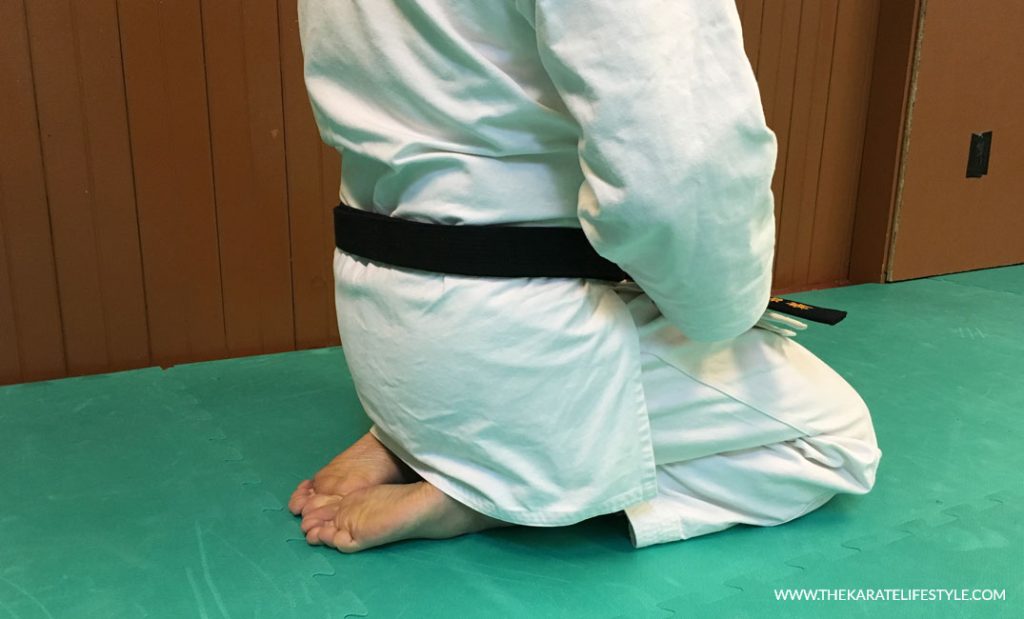
Seiza, the traditional Japanese kneeling posture, is integral to practicing Meiso and Mokuso. In this position, practitioners kneel with their legs folded underneath their thighs, keeping their backs straight and feet flat on the ground. This posture is particularly effective for keeping the spine erect, which is beneficial for maintaining proper form and aids significantly in enhancing concentration and attention. The upright spine in seiza promotes alertness and allows for better breathing, both essential for achieving the focused state of mind required in these meditation practices.
3. Hands & Arms Position
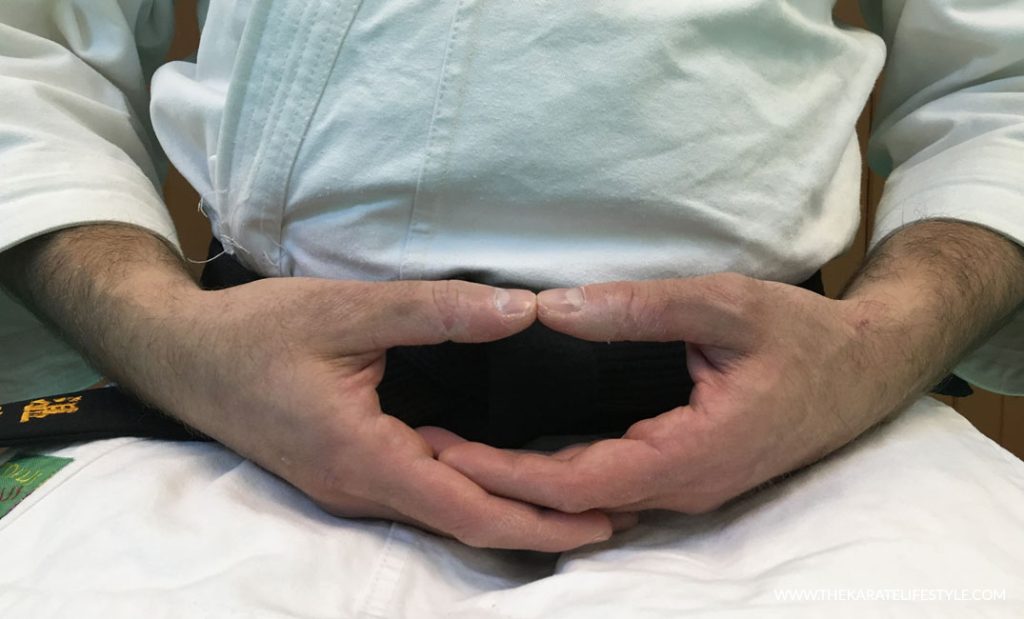
The hands and arms can be positioned in two ways: either in the hokkaijoin (a specific hand position where the right hand is placed over the left, with thumbs lightly touching to form an oval) or simply resting on the thighs.
4. Eyes
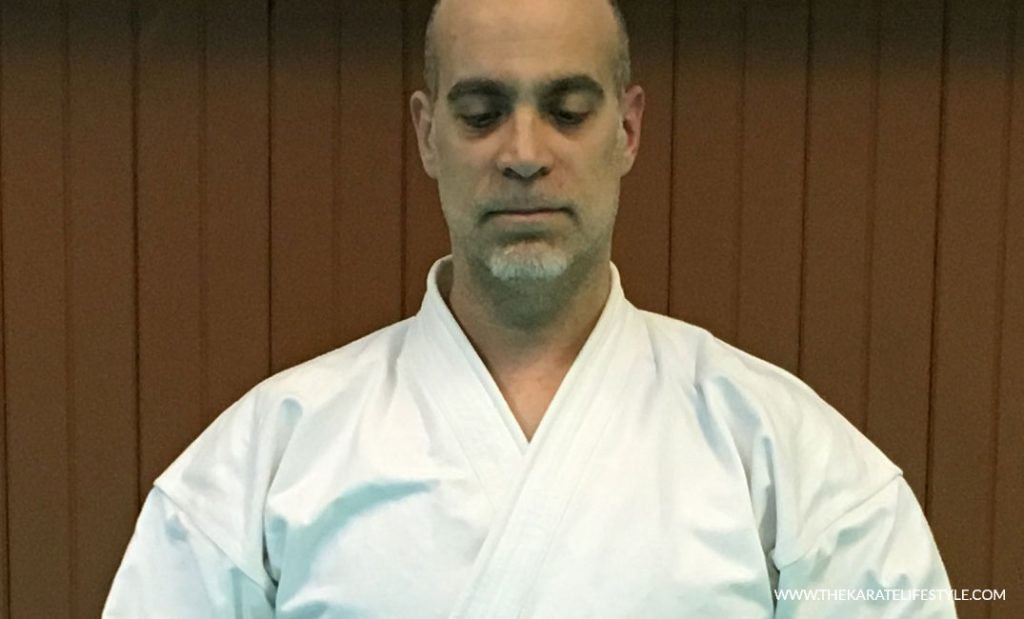
It’s generally better to keep the eyes open during meditation to avoid sleepiness. A soft gaze, not focusing on anything specific, helps maintain alertness.
5. Breathing
Breathing should be natural and relaxed. Deep, abdominal breathing is often encouraged, focusing on maintaining a steady, calm breath.
6. State of Mind
For Meiso, the aim is to reach a state of emptiness, allowing thoughts to pass without engagement, leading to deep introspection and mindfulness. Mokuso focuses more on visualizing a martial goal or aspect of training, helping to center the mind and prepare it for karate’s physical and mental challenges.
7. Ending
The meditation session concludes when the Sensei calls “Mokuso Yame!” or “Stop meditation“. After hearing this, wait for 2-3 seconds, then place your hands on your thighs and remain seated, waiting for further instructions.
This structured approach to Meiso and Mokuso helps karate practitioners mentally prepare for training, enhancing their focus, discipline, and mindfulness in martial arts.
How Long and How Often Should I Practice?
Duration
Meiso and Mokuso can be effectively practiced both in the dojo and at home, and the duration of these practices can vary based on the setting.
- In the Dojo: Typically, in a dojo setting, Meiso and Mokuso sessions are around 5 minutes long at the beginning and at the end of a class. This duration is sufficient to center your mind and prepare it for the upcoming training session or to help you transition back to a normal state of mind after intense physical and mental exertion.
- At Home: When practicing at home, you can extend the duration. A standard meditation session of Meiso or Mokuso at home can last around 20-30 minutes. This longer duration allows for a deeper meditation experience, providing more time for introspection and mental training.
Frequency
The frequency of practicing Meiso and Mokuso can also vary depending on the setting and your schedule.
- In a Dojo Setting: It’s natural to practice Meiso and Mokuso in every karate session, both at the beginning and the end. This routine helps maintain consistency and reinforces the mental discipline required for martial arts.
- At Home: Ideally, practicing Meiso and Mokuso daily at home is beneficial. Regular practice enhances the benefits of meditation, such as improved focus, reduced stress, and better mind-body coordination. Daily meditation can also be a grounding exercise, helping to maintain mental clarity and emotional balance in everyday life.
While the dojo provides a structured environment for Meiso and Mokuso, extending your practice to your home can deepen the benefits. Regular, consistent practice, whether in the dojo or at home, is key to reaping the full rewards of these meditation techniques.
Why are Meiso and Mokuso So Important?
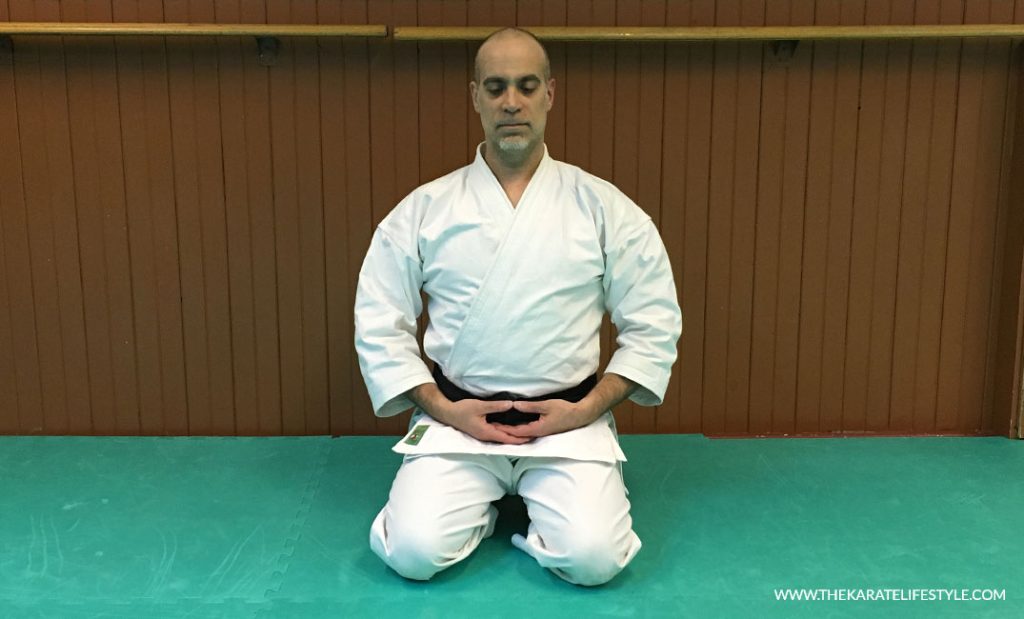
Meiso and Mokuso are not just supplementary practices in karate; they are as crucial as the physical training. These meditation techniques are fundamental in shaping the skill and character of a karate practitioner.
In the martial arts journey, where physical prowess and technical mastery are often emphasized, Meiso and Mokuso provide the essential balance by developing the mental and spiritual aspects. They ensure that a practitioner is physically adept and mentally and emotionally prepared for the challenges within and outside the dojo.
Embracing these practices is key to embodying the true essence of karate, which is a blend of physical ability, mental strength, and spiritual depth.
What are the Benefits of Meiso and Mokuso?
The practice of Meiso and Mokuso in karate brings a multitude of benefits, contributing to both martial arts training and personal well-being:
- Enhanced Focus and Concentration: Regular practice improves your ability to concentrate, a vital skill during karate training and daily life.
- Stress Reduction: These meditation techniques help in managing stress, promoting a sense of calm and relaxation.
- Improved Mind-Body Connection: They foster a deeper understanding and awareness of the body, enhancing control and coordination.
- Emotional Balance: Practicing Meiso and Mokuso aids in achieving emotional stability, helping you remain calm and composed in challenging situations.
- Increased Self-Awareness: These practices encourage introspection, leading to greater self-knowledge and personal growth.
- Better Breathing Control: They teach controlled breathing, which is crucial for executing karate techniques effectively and for overall health.
- Mental Clarity: Regular meditation clears the mind, aiding decision-making and problem-solving.
- Cultivation of Patience and Discipline: These are key martial arts virtues nurtured through consistent meditation practice.
- Spiritual Growth: Meiso and Mokuso offer a pathway to spiritual enrichment, aligning with the philosophical aspects of karate.
Incorporating Meiso and Mokuso into your karate practice is not just about enhancing your physical abilities; it’s about embarking on a comprehensive journey of self-improvement, where the mind, body, and spirit are harmoniously developed.
Conclusion
In conclusion, the practice of Meiso and Mokuso in karate transcends the conventional perception of martial arts being solely about punches and kicks. These forms of meditation are pivotal in shaping skilled martial artists and individuals who embody the essence of karate in their everyday lives.
By integrating Meiso and Mokuso into your training, you embark on a journey that nurtures inner peace, emotional balance, and a deeper understanding of oneself. Remember, karate is a discipline that fosters holistic development – physical, mental, and spiritual. It’s a path towards becoming a better human being, where each punch and kick is in harmony with a calm and focused mind.
Embrace these meditation practices as an integral part of your karate journey. Start incorporating Meiso and Mokuso into your routine, and experience their profound impact on your martial arts practice and life.
Let the journey of self-improvement and inner peace begin today.
- 10 Ways Meditation can Improve Your Karate - March 6, 2024
- Is Tai Chi Effective for Self-Defense? - February 16, 2024
- Do You Need to Add Ground Grappling Into Your Karate? - February 15, 2024

